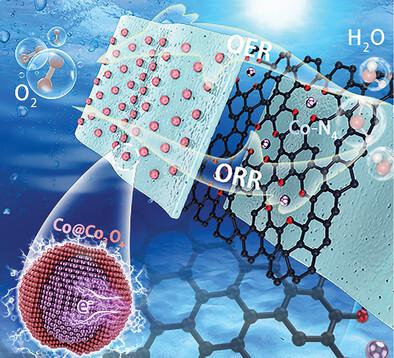Our official English website, www.x-mol.net, welcomes your feedback! (Note: you will need to create a separate account there.)
Optimizing d-Orbital Electronic Configuration via Metal–Metal Oxide Core–Shell Charge Donation for Boosting Reversible Oxygen Electrocatalysis
Small ( IF 13.0 ) Pub Date : 2023-03-18 , DOI: 10.1002/smll.202300621 Wei Wu 1 , Runzhe Chen 1 , Suhao Chen 1 , Zichen Wang 1 , Niancai Cheng 1, 2
Small ( IF 13.0 ) Pub Date : 2023-03-18 , DOI: 10.1002/smll.202300621 Wei Wu 1 , Runzhe Chen 1 , Suhao Chen 1 , Zichen Wang 1 , Niancai Cheng 1, 2
Affiliation

|
Tuning the d-orbital electronic configuration of active sites to achieve well-optimized adsorption strength of oxygen-containing intermediates toward reversible oxygen electrocatalysis is desirable for efficient rechargeable Zn-Air batteries but extremely challenging. Herein, this work proposes to construct a Co@Co3O4 core–shell structure to regulate the d-orbital electronic configuration of Co3O4 for the enhanced bifunctional oxygen electrocatalysis. Theoretical calculations first evidence that electron donation from Co core to Co3O4 shell could downshift the d-band center and simultaneously weak spin state of Co3O4, result in the well-optimized adsorption strength of oxygen-containing intermediates on Co3O4, thus contributing a favor way for oxygen reduction/evolution reaction (ORR/OER) bifunctional catalysis. As a proof-of-concept, the Co@Co3O4 embedded in Co, N co-doped porous carbon derived from thickness controlled 2D metal-organic-framework is designed to realize the structure of computational prediction and further improve the performance. The optimized 15Co@Co3O4/PNC catalyst exhibits the superior bifunctional oxygen electrocatalytic activity with a small potential gap of 0.69 V and a peak power density of 158.5 mW cm−2 in ZABs. Moreover, DFT calculations shows that the more oxygen vacancies on Co3O4 contribute too strong adsorption of oxygen intermediates which limit the bifunctional electrocatalysis, while electron donation in the core–shell structure can alleviate the negative effect and maintain superior bifunctional overpotential.
中文翻译:

通过金属-金属氧化物核-壳电荷捐赠优化 d 轨道电子构型以促进可逆氧电催化
调整活性位点的 d 轨道电子构型,以实现含氧中间体对可逆氧电催化的充分优化的吸附强度,对于高效可充电锌空气电池来说是理想的,但也极具挑战性。在此,本工作提出构建Co@Co 3 O 4核壳结构来调节Co 3 O 4的d轨道电子构型,以增强双功能氧电催化。理论计算首次证明从Co核到Co 3 O 4壳层的电子供给可以使d带中心下移,同时降低Co 3 O 4的弱自旋态,导致含氧中间体在Co 3 O 4上的吸附强度得到优化,从而为氧还原/析出反应(ORR/OER)双功能催化提供了有利的途径。作为概念验证,Co@Co 3 O 4嵌入由厚度控制的二维金属有机框架衍生的Co、N共掺杂多孔碳中,旨在实现计算预测的结构并进一步提高性能。优化后的15Co@Co 3 O 4 /PNC催化剂表现出优异的双功能氧电催化活性,电位差小至0.69 V,峰值功率密度为158.5 mW cm -2在 ZAB 中。此外,DFT计算表明,Co 3 O 4上较多的氧空位对氧中间体的吸附过强,限制了双功能电催化,而核壳结构中的电子供给可以减轻负面影响并保持优异的双功能过电势。
更新日期:2023-03-18
中文翻译:

通过金属-金属氧化物核-壳电荷捐赠优化 d 轨道电子构型以促进可逆氧电催化
调整活性位点的 d 轨道电子构型,以实现含氧中间体对可逆氧电催化的充分优化的吸附强度,对于高效可充电锌空气电池来说是理想的,但也极具挑战性。在此,本工作提出构建Co@Co 3 O 4核壳结构来调节Co 3 O 4的d轨道电子构型,以增强双功能氧电催化。理论计算首次证明从Co核到Co 3 O 4壳层的电子供给可以使d带中心下移,同时降低Co 3 O 4的弱自旋态,导致含氧中间体在Co 3 O 4上的吸附强度得到优化,从而为氧还原/析出反应(ORR/OER)双功能催化提供了有利的途径。作为概念验证,Co@Co 3 O 4嵌入由厚度控制的二维金属有机框架衍生的Co、N共掺杂多孔碳中,旨在实现计算预测的结构并进一步提高性能。优化后的15Co@Co 3 O 4 /PNC催化剂表现出优异的双功能氧电催化活性,电位差小至0.69 V,峰值功率密度为158.5 mW cm -2在 ZAB 中。此外,DFT计算表明,Co 3 O 4上较多的氧空位对氧中间体的吸附过强,限制了双功能电催化,而核壳结构中的电子供给可以减轻负面影响并保持优异的双功能过电势。














































 京公网安备 11010802027423号
京公网安备 11010802027423号